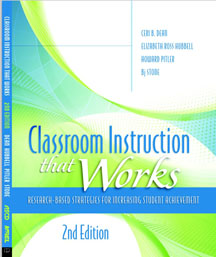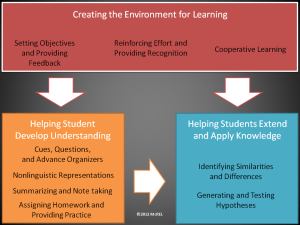
Yet, what a difference a decade can make! Since that initial publication, our profession has been enlightened by the works of Carol Dweck, John J. Medina, Linda Darling-Hammond, Nancy Frey, and many others. We know more now about student motivation, providing feedback, the power of multimedia and images, and scaffolding learning that we ever did before. While we have been humbled by the success of the first edition of CITW, it became more and more apparent that the work was in need of an update as we helped educators learn the nuances of the nine categories of effective strategies. In addition to including emerging research in the field, we felt the need to make correlations with dynamic developments in educational technology and an increased focus on 21st century skills.
Perhaps our biggest incentive for rewriting the book came from our experiences in working with thousands of schools and districts on learning CITW. As we talked with educators and school or district leaders, we realized that there were parts of the first version of CITW that were confusing or unclear. For instance, the 2001 publication lists the strategies in order of impact on effect size, starting with Identifying Similarities and Differences and ending with Cues, Questions, and Advance Organizers. This sent an unintended message to readers that those strategies listed at the top were of higher priority than those at the bottom. Countless times, we heard clients say they intended to focus on the “best” strategies that school year and, if time allowed, they would turn their efforts to the “lower” strategies. This was, of course, no fault of school leaders or educators; it simply reflected changes we knew we wanted to make.

We also reference how these strategies integrate with new technologies and 21st century learning. In the new research, the strategies have remained the same, but the findings and how we talk about them has changed. To that end, each strategy in the second edition of CITW includes the following sections.
Why this Category is Important includes findings from the new research and how these differ or are in support of findings from the initial meta-analysis.
Classroom Practice gives practical classroom recommendations as well as vignettes to help readers see the strategy in action.
Today’s Learners outlines how these recommendations fit with 21st century classrooms, student-centered instruction, and modern technologies.
Tips for Teaching gives key points or take-aways from the chapter.
Classroom Instruction That Works, Second Edition, takes a classic publication on instruction and makes it fresh by drawing from new research, providing better organization of the strategies, and addressing its relevance to our classrooms today. The book will be available on January 16 from www.ascd.org. We look forward to hearing your feedback!

Very insightful thanks, It’s my opinion your followers would likely want much more posts that adheres to that carry on favorable content.
Having used the first edition of CITW to guide practice for some ten years, I am excited about the release of the second edition. Recalling the state of our schools ten years ago compared to now, it is essential to consider what these instructional practices will look like for 21st-Century Learners. Hopefully, readers will consider this work from a holistic standpoint to determine what research-based strategies will work best for their schools.